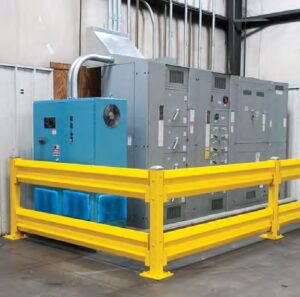
We are going to compare Single High GuardRails and Double High GuardRails. We will show you the differences between the gurad rails as well as their similarities. They share many of the same features. However, there are several differences to keep in mind as you decide which one is the better fit for your organization’s needs.
The Differences between the Guard Rail Products
Different Specs
Guardrails -– also called standard railings -– are the primary means of preventing employees from falling to lower levels in general industry as required under 1910.23(c). Specifically, all platforms 4 feet or more above the adjacent floor or ground must be protected by a standard guardrail on all open sides. This includes mezzanines, loading docks, roofs, etc. In addition, toeboards are often necessary to prevent the fall of materials to a lower level and to keep an employee’s feet from slipping over an edge.
Under 1910.23(e)(1), OSHA says that a guardrail must have a vertical height of 42 inches nominal from the upper surface of the top rail to floor, platform, runway, or ramp level. “Nominal” simply means that 42 inches has been established as the de facto standard for guardrail height. OSHA allows for variance, however. Standard Directive 1-1.10 says existing guardrails must consist of a
The most notable difference ibetween the guard rail products is obvious in the name. One utilizes only a single rail between two columns, while the other product uses an additional rail.
An optional 3′ or 4′ wide hinged door is only available with the double high guard rail. However, a lift-out rail can be applied to both types.
Different Uses
The manufacturer’s survey has found that many customers prefer double high GuardRail over single high. We think this is because it’s been used more commonly for many years, especially in industrial facilities. The double rails, and subsequent extra height, make it a more obvious physical and visual cue. Warehouse guard railing systems are an essential safety component within your facility. Guard rail provides a physical and visual barrier to protect from forklift and powered vehicle accidents. The rail system can be installed along pedestrian walkways to keep your employees safe. This can be very important for safety around large machinery.
However, single high GuardRail is very common in warehouses at the end of racks. It can be used to create a buffer around corners and to separate aisle-ways, so people clearly see where to walk and avoid bumping into materials.
Many times, this use of a single high guard rail is not required by organizations like OSHA. They’re just an example of going the extra mile for safety, organization, and the employee experience.
Don’t Forget the Similarities in these GuardRails
Both of our GuardRail products were designed and tested to withstand the impact of a 10,000-pound load moving at 4 miles per hour. Their differing heights do not change their strength.
The rails are mounted to columns with 1/2″ x 5″ through bolts. All stock rails are powder coated safety yellow. Although columns come in 2 different heights in order to accommodate single versus double rails, all our GuardRail columns are a 4″ square x 1/4″ wall structural steel tubing with metal caps, and 9″ square x 1/2″ thick steel base plates.
We can customize our Guardrail products to include more than 2 railings as well. The tallest guardrail system we’ve provided to an organization so far was 4 GuardRails high! That custom piece of equipment provided a barrier around tall machinery. It was also stationed at a corner that had lots of truck traffic.
For both product types, our 11-gauge formed steel rails come in standard lengths to reach even foot increments, center to center, of each column. Those length options range from 0′-8″ all the way up to 9′-8″.
These are the sizes we keep in stock. Different standard rail lengths can even be used together as one guardrail system We can customize your overall guardrail system, but we won’t make rail lengths any longer than 9 foot 8 inches because we have to ensure our measurements can uphold our strength standards. If you need a longer safety barrier than our standard rail length options provide, we’ll add additional sections to your GuardRail system.
How these Factors Affect Purchasing Decisions
It’s best for managers to make equipment decisions based on their safety needs. We know, however, that cost can be a factor. As you might expect, our double high GuardRail costs more than single high because you’re getting double the material. Many people still prefer double-high as we mentioned. In many cases it’s double the protection! That’s something to consider.
Both of these products do well to save you the expense of costly downtime and repairs because they both prevent accidents and damage. Your people and your products are worth it! Contact us today for additional information.
